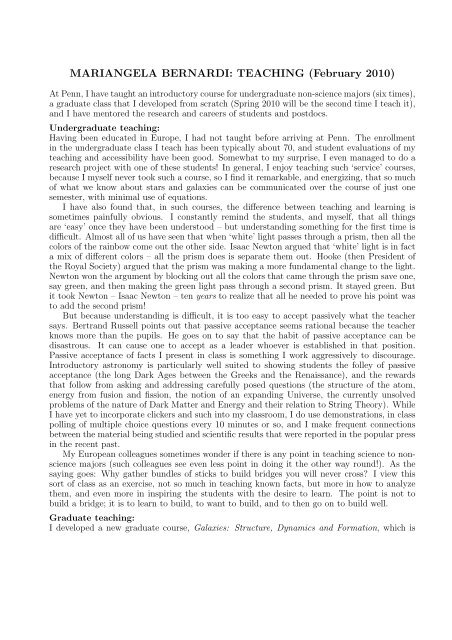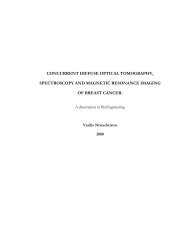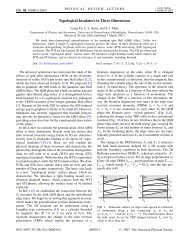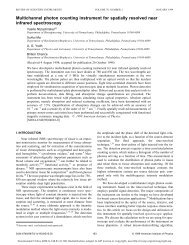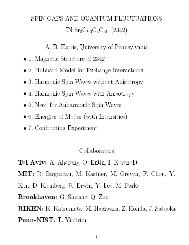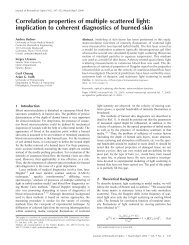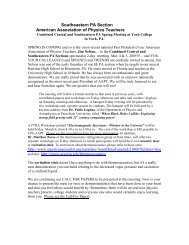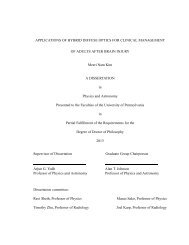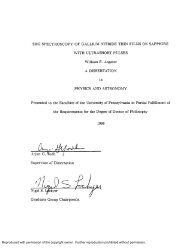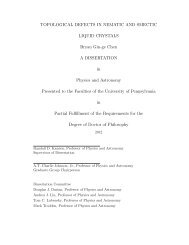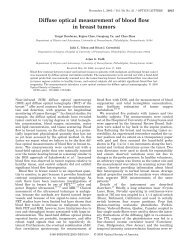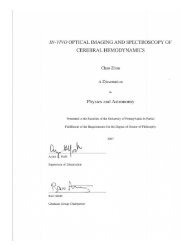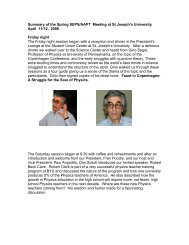Teaching Statement - Department of Physics and Astronomy
Teaching Statement - Department of Physics and Astronomy
Teaching Statement - Department of Physics and Astronomy
Create successful ePaper yourself
Turn your PDF publications into a flip-book with our unique Google optimized e-Paper software.
MARIANGELA BERNARDI: TEACHING (February 2010)<br />
At Penn, I have taught an introductory course for undergraduate non-science majors (six times),<br />
a graduate class that I developed from scratch (Spring 2010 will be the second time I teach it),<br />
<strong>and</strong> I have mentored the research <strong>and</strong> careers <strong>of</strong> students <strong>and</strong> postdocs.<br />
Undergraduate teaching:<br />
Having been educated in Europe, I had not taught before arriving at Penn. The enrollment<br />
in the undergraduate class I teach has been typically about 70, <strong>and</strong> student evaluations <strong>of</strong> my<br />
teaching <strong>and</strong> accessibility have been good. Somewhat to my surprise, I even managed to do a<br />
research project with one <strong>of</strong> these students! In general, I enjoy teaching such ‘service’ courses,<br />
because I myself never took such a course, so I find it remarkable, <strong>and</strong> energizing, that so much<br />
<strong>of</strong> what we know about stars <strong>and</strong> galaxies can be communicated over the course <strong>of</strong> just one<br />
semester, with minimal use <strong>of</strong> equations.<br />
I have also found that, in such courses, the difference between teaching <strong>and</strong> learning is<br />
sometimes painfully obvious. I constantly remind the students, <strong>and</strong> myself, that all things<br />
are ‘easy’ once they have been understood – but underst<strong>and</strong>ing something for the first time is<br />
difficult. Almost all <strong>of</strong> us have seen that when ‘white’ light passes through a prism, then all the<br />
colors <strong>of</strong> the rainbow come out the other side. Isaac Newton argued that ‘white’ light is in fact<br />
a mix <strong>of</strong> different colors – all the prism does is separate them out. Hooke (then President <strong>of</strong><br />
the Royal Society) argued that the prism was making a more fundamental change to the light.<br />
Newton won the argument by blocking out all the colors that came through the prism save one,<br />
say green, <strong>and</strong> then making the green light pass through a second prism. It stayed green. But<br />
it took Newton – Isaac Newton – ten years to realize that all he needed to prove his point was<br />
to add the second prism!<br />
But because underst<strong>and</strong>ing is difficult, it is too easy to accept passively what the teacher<br />
says. Bertr<strong>and</strong> Russell points out that passive acceptance seems rational because the teacher<br />
knows more than the pupils. He goes on to say that the habit <strong>of</strong> passive acceptance can be<br />
disastrous. It can cause one to accept as a leader whoever is established in that position.<br />
Passive acceptance <strong>of</strong> facts I present in class is something I work aggressively to discourage.<br />
Introductory astronomy is particularly well suited to showing students the folley <strong>of</strong> passive<br />
acceptance (the long Dark Ages between the Greeks <strong>and</strong> the Renaissance), <strong>and</strong> the rewards<br />
that follow from asking <strong>and</strong> addressing carefully posed questions (the structure <strong>of</strong> the atom,<br />
energy from fusion <strong>and</strong> fission, the notion <strong>of</strong> an exp<strong>and</strong>ing Universe, the currently unsolved<br />
problems <strong>of</strong> the nature <strong>of</strong> Dark Matter <strong>and</strong> Energy <strong>and</strong> their relation to String Theory). While<br />
I have yet to incorporate clickers <strong>and</strong> such into my classroom, I do use demonstrations, in class<br />
polling <strong>of</strong> multiple choice questions every 10 minutes or so, <strong>and</strong> I make frequent connections<br />
between the material being studied <strong>and</strong> scientific results that were reported in the popular press<br />
in the recent past.<br />
My European colleagues sometimes wonder if there is any point in teaching science to nonscience<br />
majors (such colleagues see even less point in doing it the other way round!). As the<br />
saying goes: Why gather bundles <strong>of</strong> sticks to build bridges you will never cross? I view this<br />
sort <strong>of</strong> class as an exercise, not so much in teaching known facts, but more in how to analyze<br />
them, <strong>and</strong> even more in inspiring the students with the desire to learn. The point is not to<br />
build a bridge; it is to learn to build, to want to build, <strong>and</strong> to then go on to build well.<br />
Graduate teaching:<br />
I developed a new graduate course, Galaxies: Structure, Dynamics <strong>and</strong> Formation, which is
now one <strong>of</strong> the four pillars <strong>of</strong> the Penn Astrophysics Graduate Program. I taught this course for<br />
the first time in Fall 2008, <strong>and</strong> received positive student reviews. This course covered various<br />
observational aspects <strong>of</strong> the subject (the many details involved in going from the photon counts<br />
at the telescope to calibrated photometry <strong>of</strong> extended objects, how one estimates velocity<br />
dispersions, how one accounts for selection effects such as those which arise from the fact<br />
that we typically see the most luminous objects to greater distances so most catalogs are biased<br />
against faint objects, <strong>and</strong> that the more distant objects appear redder than they are intrinsically<br />
because <strong>of</strong> the expansion <strong>of</strong> the universe), statistical estimation techniques to quantify the<br />
intrinsic correlations between observables (e.g., maximum-likelihood <strong>and</strong> principle component<br />
analysis), the physics <strong>of</strong> the objects (how to interpret the observed correlations using physical<br />
models <strong>of</strong> disks <strong>and</strong> triaxial virialized systems), <strong>and</strong> how one obtains information about their<br />
formation from data at a single epoch, or over a range <strong>of</strong> look-back times (e.g., using stellar<br />
population synthesis models).<br />
I also used the course as an opportunity to familiarize the students with the numerical<br />
nature <strong>of</strong> most astrophysical research – whereas class time was devoted to concepts, homework<br />
sets were computationally heavy. My experience convinced me that this would be better taught<br />
as a two course sequence – the first semester emphasizing the observations, <strong>and</strong> the second,<br />
the implications for models <strong>of</strong> galaxy formation (which are currently covered too rapidly at<br />
the end), particularly regarding the correlations between evolution <strong>and</strong> environment – i.e., the<br />
connection between cosmology, large scale structure, <strong>and</strong> galaxy formation.<br />
Mentoring research:<br />
There are many respects in which teaching in the classroom <strong>and</strong> mentoring graduate students<br />
<strong>and</strong> postdocs in their research differ. I said earlier that the former is about filling students with<br />
the desire to learn. The latter, mentoring, is almost an exercise in making oneself unnecessary.<br />
In mentoring graduate students <strong>and</strong> postdocs so far, I feel I have had the benefit <strong>of</strong> sampling<br />
both the best <strong>and</strong> the worst experiences. Interactions with my first postdoc were not very<br />
productive; although difficult, I acted quickly to improve things, <strong>and</strong> happily, the person who<br />
replaced him has been much more productive. In contrast, my first graduate student, Joey<br />
Hyde, was smart, hard-working, <strong>and</strong> an absolute pleasure to have as a colleague. In addition<br />
to doing great work for his thesis, he served for a while as the computer support person for the<br />
Astro group. I view him as a particular success story because his admission to the program<br />
was due in part to my reassuring the Admissions committee that I thought he had ‘what it<br />
takes’. He successfully defended his PhD within 5 years <strong>of</strong> his arrival at Penn; if I am able to<br />
identify another student who is even half as good as he, I will count myself lucky. In addition, I<br />
am also mentoring graduate students <strong>of</strong> collaborators at other institutions (both domestic <strong>and</strong><br />
international). The students have spent some time at Penn <strong>and</strong> have co-authored publications<br />
(in one case, the student served as the lead author, <strong>and</strong> will soon be starting a postdoctoral<br />
position). I expect they will return at least one more time before completing their degrees.


